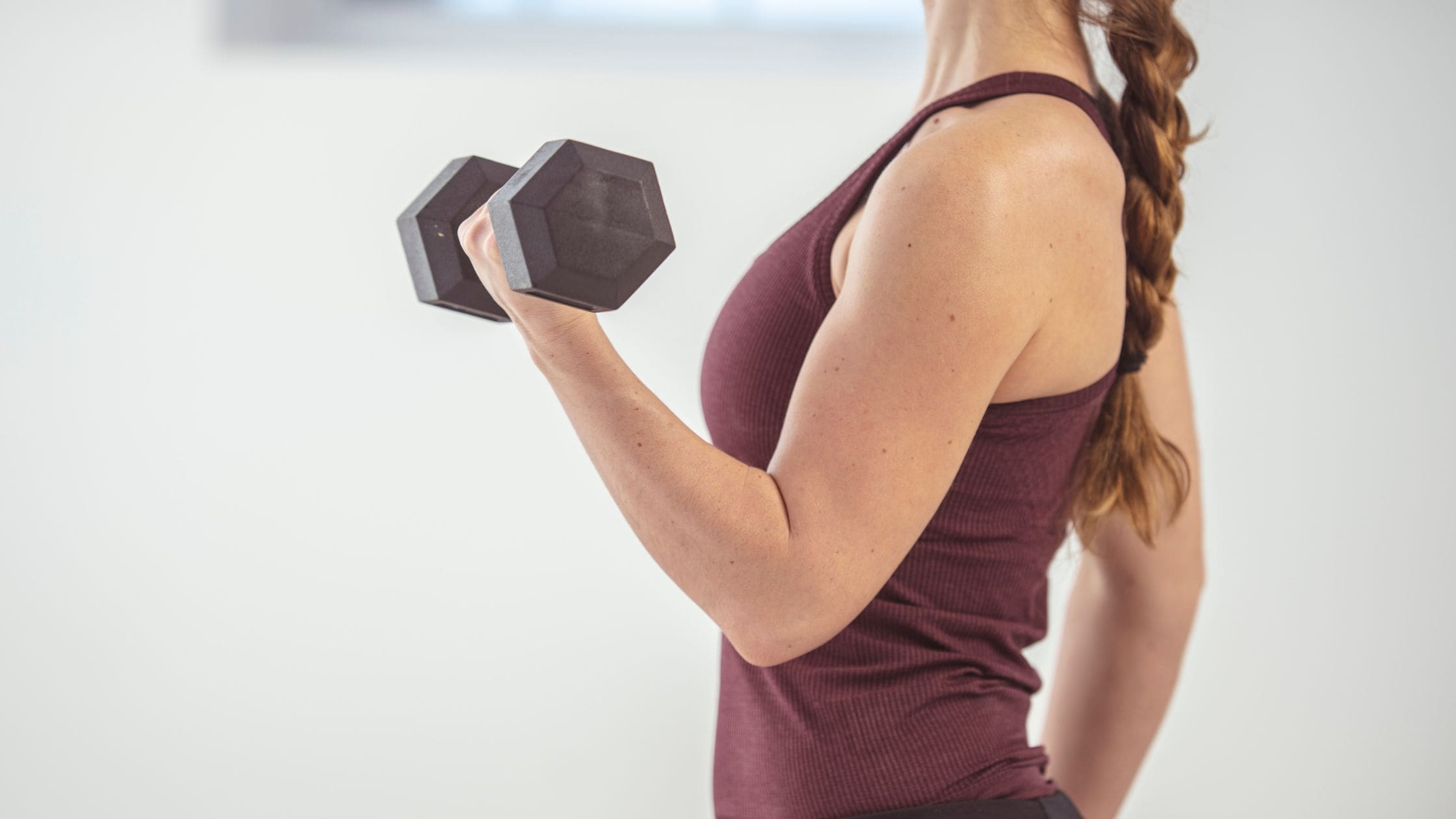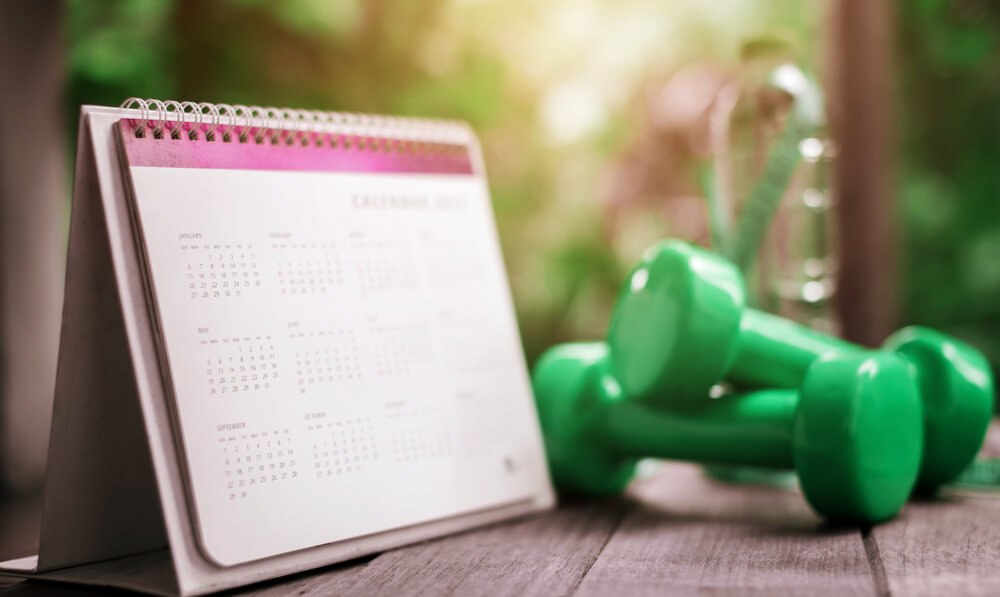Resistance band, fitness band, TheraBand – this prop is known by lots of different names. But, regardless of what you call it, the stretchy band has many great properties making it the perfect addition to any Pilates workout.
For Pilates fans looking for a challenge, resistance band Pilates can make both mat and equipment exercises more difficult. Plus, including it in a mat routine creates new and exciting exercise possibilities.
And its benefits don’t end there.
Like the Pilates ball, the resistance band is cheap, convenient and portable. It is also easy to roll up and store at home or carry in a suitcase.
The more you learn about the advantages of the resistance band, the more likely you are to use it. It’s why we’ve brought you this “Introduction to the Pilates small props – the resistance band”.
What is a resistance band?
Resistance bands are made from elastic. They come in multiple resistance levels, usually light, medium or heavy.
There are other variables when it comes to the design of resistance band. For instance, the standard band is just one long strip of elastic. Others have handles or are continuous loops.
These various bands are designed to be used for different purposes, and it can be helpful to have a range of them in your home collection.
Having said that, the standard design can be adapted to suit most exercises.
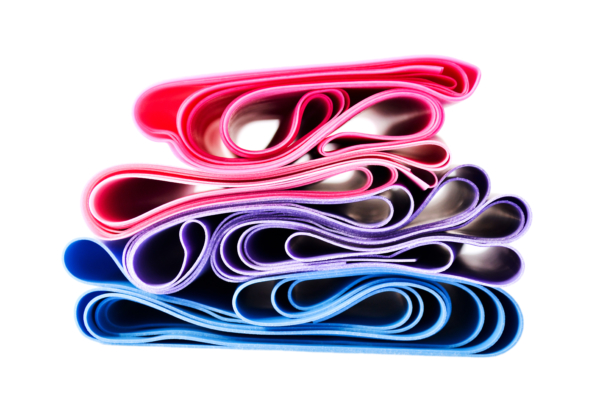
Set of latex resistance bands for fitness, muscle building and rehabilitation.
Uses of resistance bands in Pilates
The best way to use resistance bands in Pilates
To challenge the body
Using resistance bands is an effective way of recreating equipment exercises at home or when travelling.
For instance, stepping on one end or looping it around a fixed object helps recreate the pulley or spring system of the Pilates machines.
We find this aspect of the resistance band particularly useful as Pilates teachers. Because, as well as using them in our classes at Complete Pilates, the design of theses bands means that we also assign our clients band exercises to keep up with their studio exercises at home.
As their name suggests, these bands can also be used to add resistance to an exercise and therefore increase the difficultly level of it.
An example of this in action is the short box “ab series” on the reformer. This group of ab exercises can be performed with arms overhead. This action challenges balance, abdominal control and gets the upper body working.
Now, this move can be done with a pole between the arms. However, the addition of a band between the hands overhead is also a popular choice. The inclusion of a band – which is then pulled apart to activate the shoulders and arms – transforms this ab move into a full-body exercise.
To support the body
Despite doing an excellent job of making exercises more difficult, that is not all resistance bands are good for. Instead, they can also be an assistive prop used to make exercises more achievable.
For example, a light looped resistance band around the thighs during reformer footwork can act as a guide for the legs. If they are rolling in wards, for instance, a gently press outwards on the band keeps the legs tracking in good alignment.
For these reasons, this prop is particularly useful in Pilates sessions for beginners or for people with injuries.
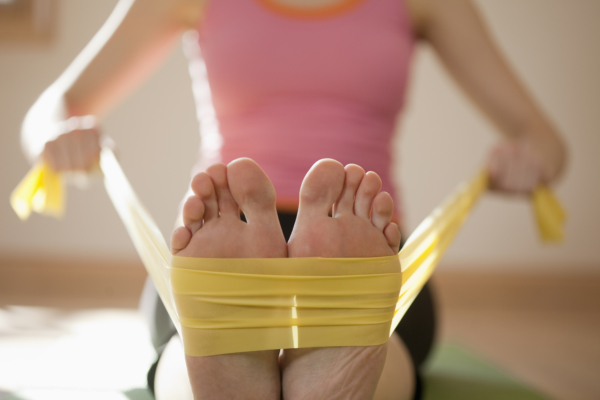
There are many different exercises with resistance bands.
What are Pilates bands good for?
From the perspective of a Pilates teacher, one of the best things about resistance bands is that they are a lightweight and portable alternative to the equipment. This makes getting your reformer fix at home or on holiday easy.
Another plus: the tension created by resistance bands can be easily adjusted. Different bands can be used to suit different needs and abilities. And the tension can be altered even further in various way.
For those wanting to increase the challenge of an exercise and build strength, multiple bands can be used together. If less tension is needed, slacking your hold on a band is always an option.
Another big benefit of the resistance bands is that they help to make many mat exercises more enjoyable and effective. This is because they can be used like the pulleys and springs of the equipment to support the body.
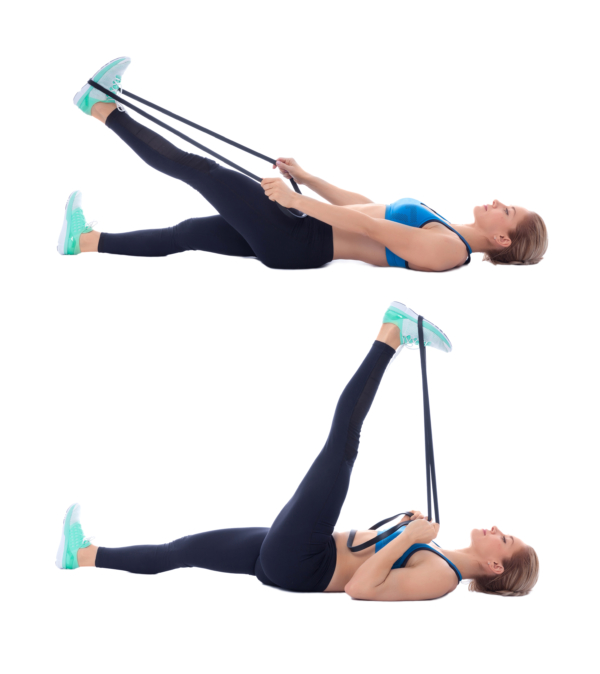
Resistance band exercises.
Pilates resistance band exercises for legs
Side lying hip raises
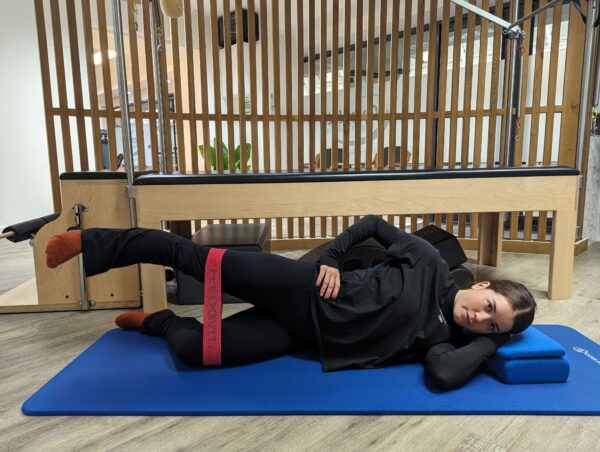
Place a loop band around your thigh or ankle (more difficult)
- Lie on your side and bend the bottom leg to improve stability
- Lift and lower the top leg with control, keeping your pelvis and trunk steady
- Repeat 3 sets of 12-15 repetitions each side
Crab Walks
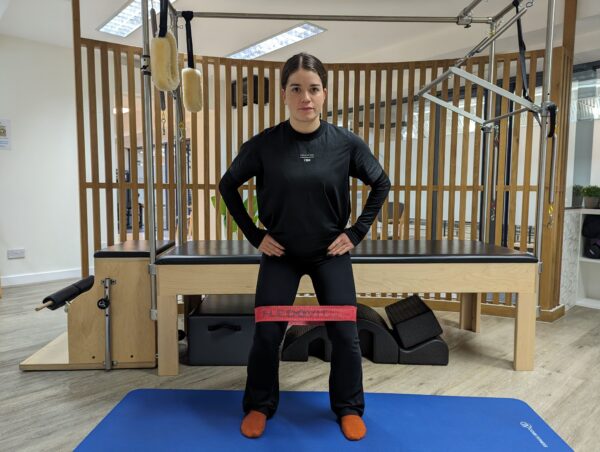
Place a loop band around your thighs or ankles (more difficult)
- Bend your knees and sit back into a quarter squat, keeping your back flat
- Start with your feet hip-width apart
- Start in one direction, eg. Step your left foot out to the side of your body, pushing against the resistance band. Follow with your right foot now, ensuring once you’ve taken two steps, your feet are still hip-width apart.
- Keep stepping to the left for 10 steps. Then repeat this to the right.
- Repeat this for up to 2 minutes or until your muscle are fatigued
Seat Knee Extension
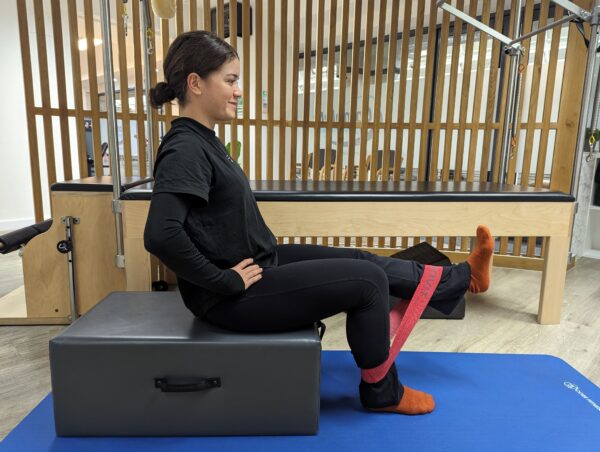
- Place a loop band around your ankles and sit on a chair
- Use one leg to anchor the band keeping it still in seated position
- Straighten the working leg at the knee as far as possible against the bands resistance
- Hold in the straight leg position for 3 seconds, then slowly lower
- Repeat 3 sets of 8-12 repetitions on each side
Prone hamstring curl
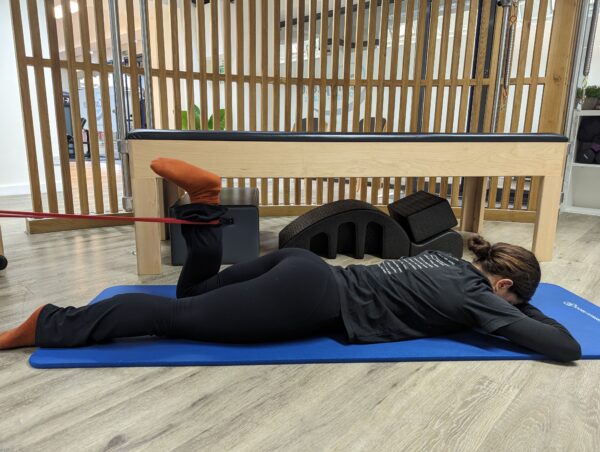
Place a loop band around your feet and lie on your stomach. You can place a pillow under your hips if this position irritates your lower back.
- Use one leg as an anchor for the band, keeping it long and still
- Pull the other heel towards your bottom against the bands resistance
- Hold in the bent knee position for 3 seconds, then slowly lower
- Repeat for 3 sets of 8-12 repetitions on each side
Pilates resistance band exercises for arms
Resisted shoulder raise

Place a loop band around the middle of your forearms
- Standing or sitting, lengthen arms in front of you resting on your thighs, palms facing inwards
- Pull both arms out against the band
- Keep pressure out against the band and raise your arms in front of you, as high as you can, then slowly lower back down
- If this is too hard, bend your elbows to 90 degrees and keep them bent throughout the shoulder movement
- Repeat 3 sets of 8-12 repetitions
Bent over shoulder fly
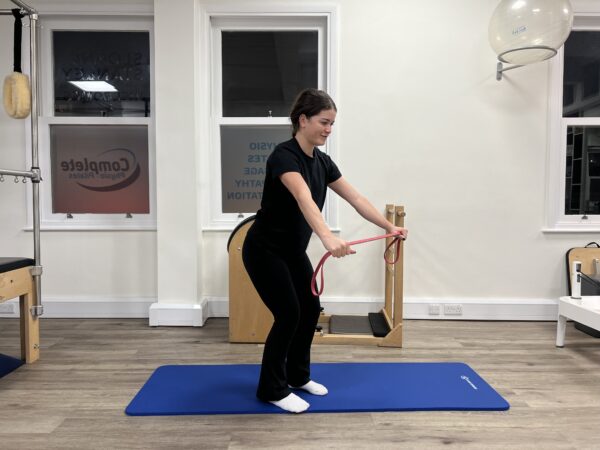
- Hold long band at each end with both hands
- Bend your knees into a quarter squat and lean forward from your hips, keeping your back straight
- Start with your arms reached ahead in the midline of your body and pull the band out to the side with both hands
- Slowly control the band as you bring the arms back to starting point
- Repeat 3 sets of 8-12 repetitions
Overhead tricep press
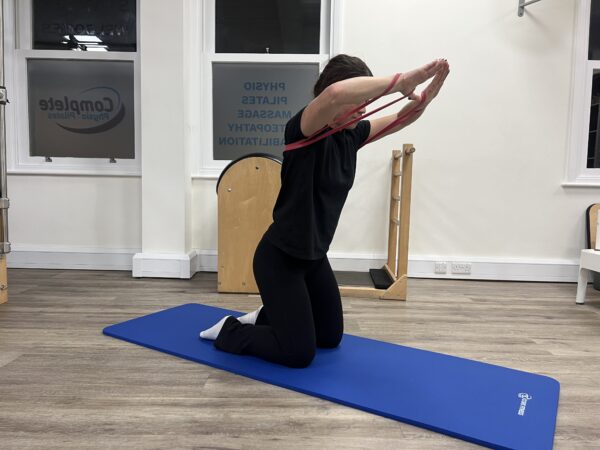
- Kneel, sit on a chair or stand for this exercise
- Loop a long band or long loop band behind your upper back, across the shoulder blades
- At each end, hold the band by looping around the thumbs or gripping the band with a fist
- Make a diamond shape with your thumbs and index fingers and place the back of your hands on your forehead with elbows out wide
- Press the hands up and away from you, straightening the elbow
- Slowly return the hands back to the forehead
- Repeat 3 sets of 8-12 repetitions
Chest Fly

- Kneel or stand for this exercise. If you need a more stable base in standing, try a split foot position with your dominant leg behind you
- Loop a long band or long loop band behind your upper back, across the shoulder blades
- At each end, hold the band by looping around the thumbs or gripping the band with a fist
- Start with your arms reaching long out to the side at shoulder height, making sure you have enough tension on the band in this position
- With elbows remaining soft, draw the hands arms together without bending your elbows further
- Slowly bring the arms back out to the side, controlling the band
- Repeat 3 sets of 8-12 repetitions
Pilates resistance band exercises for the core
Pallof press
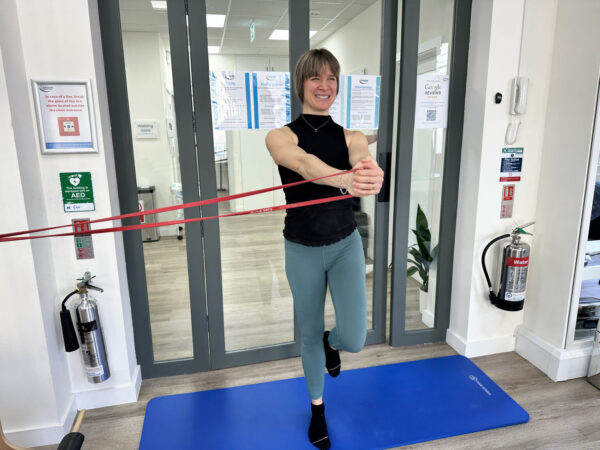
- Using a long band, secure it around a post or something steady and heavy
- Stand side on to the post and take the band in both fists, drawing it to the centre of your chest
- Stand on two legs, or to challenge yourself, lift the leg closest to the post off the floor
- Push your arms straight out in front of your chest. You should feel the band wanting to rotate you around towards the post. If not, step further from the post or choose a heavier band
- Pull the arms back in towards the centre of your chest
- Repeat 2 sets of 15-20 each side
Hundreds

- Using a long band, secure it around a post or something steady and heavy
- Lie on your back on the floor with your knees bent and the band coming from behind your head
- Grip the end of the band and hold it overhead with your arms straight
- Pull the band down towards the outside of your hips and curl your upper body off the mat
- To make it more challenging, try extending one or two legs out in front of you as you curl up
- Repeat 3 sets of 5-8 repetitions
Leg lift and lowers
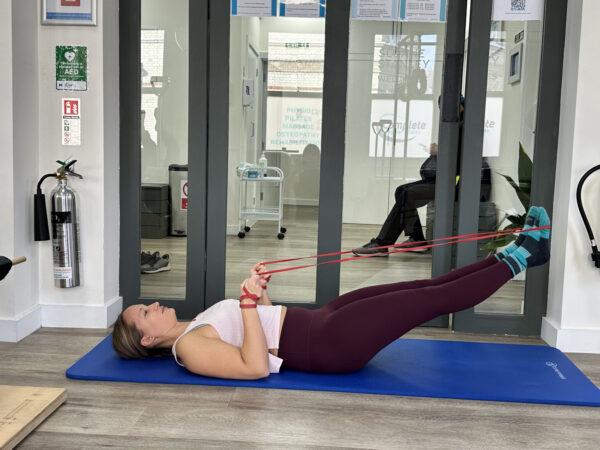
- Using a long loop, lie on your back with one end looped around your feet, holding the other end in your hands
- Start with the legs straight and feet pointed towards the ceiling
- Ensure your pelvis and spine are heavy into the floor beneath you
- Keeping good tension on the band, slowly lower both legs as far as you can before your back wants to arch
- Lift the legs back to starting position
- Repeat 3 sets of 5-8 repetitions
Standing oblique side bends

- Use a long band and secure one end firmly under both feet, holding the other end of the band with one hand, ensuring some tension on the band
- Keeping your hips still, slowly bend down to the side holding the band
- Stand up straight, pulling the band as you go while keeping the arm straight
- Repeat 3 sets of 8-12 each side
Why not try our full 15 minute resistance band workout at home?
Would you like to learn more about other props you can use at home or during a Pilates class?
- Foam roller: An introduction to Pilates small props – foam roller Pilates
- Pilates ball: What is a Pilates ball? Pilates Ball Exercises
- Magic circle: The Magic Circle: Pilates Ring Exercises & Benefits
If you would like any more advice and guidance around Pilates and using resistance bands, please do not hesitate to get in touch with us, or book an appointment at one of our Pilates studios in London. You can find us at Complete Pilates in North London, Kensington or our Pilates studio in London City.
These blogs are designed to give information to everyone, however, it is important to remember that everyone is different! If you have not seen one of our therapists and have any questions about injuries, what you have read or whether this may be useful to you, please just ask. We are more than happy to help anyone and point you in the right direction. Our biggest belief is that education is key. The more you understand about your injury, illness and movement, the more you are likely to improve.


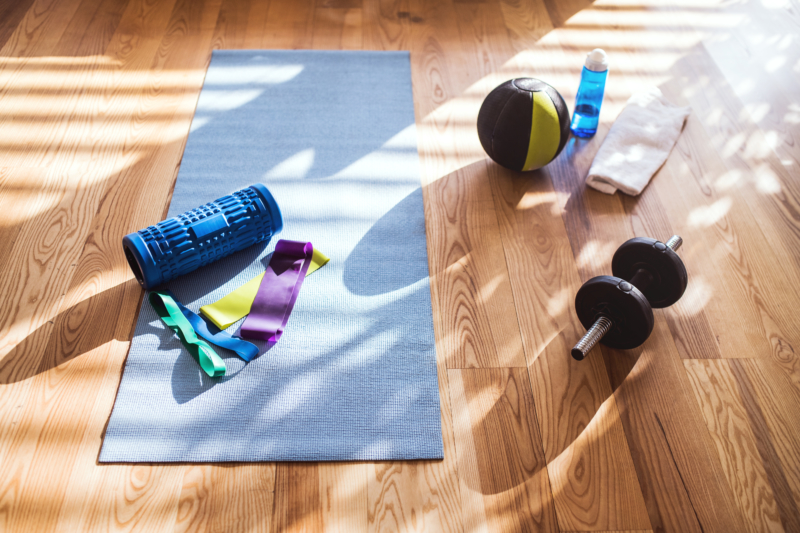
 Place a loop band around your thigh or ankle (more difficult)
Place a loop band around your thigh or ankle (more difficult)